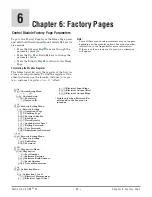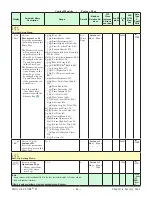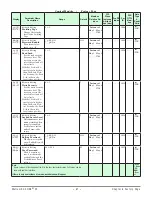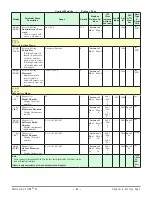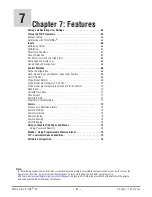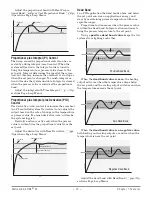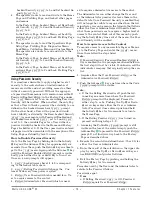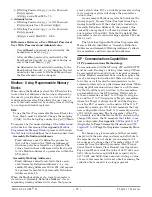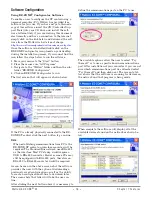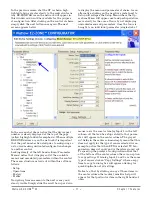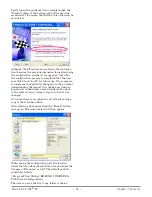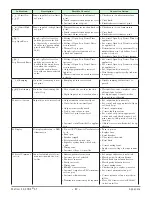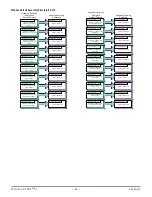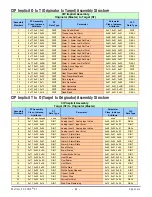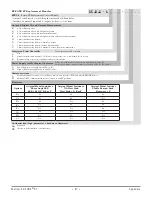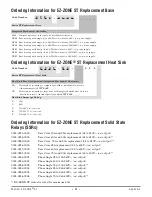
Watlow EZ-ZONE
®
ST
•
73
•
Chapter 7 Features
Alarm Silencing
If alarm silencing is on the operator can disable the
alarm output while the controller is in an alarm state.
The process value or temperature has to enter the
normal operating range beyond the hysteresis zone to
activate the alarm output function again.
An active message, such as an alarm message, will
cause the display to toggle between the normal set-
tings and the active message in the upper display and
[Attn]
in the lower display.
Push the Advance Key
‰
to display
[ignr]
in the
upper display and the message source in the lower
display.
Use the Up
¿
and Down
¯
keys to scroll through
possible responses, such as Clear
[`CLr]
or Silence
[`SiL]
. Then push the Advance
‰
or Infinity
ˆ
key to
execute the action.
See the Keys and Displays chapter and the Home
Page chapter for more details.
Turn alarm silencing on or off with Silencing
[`A;Si]
(Setup Page, Alarm Menu).
Alarm Blocking
Alarm blocking allows a system to warm up after it
has been started up. With alarm blocking on, an alarm
is not triggered when the process temperature is ini-
tially lower than the alarm low set point or higher
than the alarm high set point. The process tempera-
ture has to enter the normal operating range beyond
the hysteresis zone to activate the alarm function.
If the EZ-ZONE ST has an output that is function-
ing as a deviation alarm, the alarm is blocked when
the set point is changed, until the process value re-
enters the normal operating range.
Turn alarm blocking on or off with Blocking
[`A;bL]
(Setup Page, Alarm Menu).
Using Lockout to Hide Pages and Menus
If unintentional changes to parameter settings might
raise safety concerns or lead to downtime, your can
use the lockout feature to make them more secure.
Each of the menus in the Factory Page and each
of the pages, except the Factory Page, has a security
level assigned to it. You can change the read and write
access to these menus and pages by using the param-
eters in the Lockout Menu (Factory Page).
Lockout Menu
There are five parameters in the Lockout Menu (Fac-
tory Page):
• Lock Operations Page
[LoC;o]
sets the security lev-
el for the Operations Page. (default: 2)
Note:
The Home and Setup Page lockout levels are fixed
and cannot be changed.
• Lock Profiling Page
[LoC;P]
sets the security level
for the Profiling Page. (default: 3)
• Password Security Enable
[pas;e]
will turn on or
off the Password security feature. (default: off)
• Read Lockout Security
[rLoC]
determines which
pages can be accessed. The user can access the se-
lected level and all lower levels. (default: 5)
• Set Lockout Security
[SLoC]
determines which pa-
rameters within accessible pages can be written to.
The user can write to the selected level and all
lower levels. (default: 5)
The table below represents the various levels of lock-
out for the Set Lockout Security prompt and the Read
Lockout Security prompt. The Set Lockout has 6 levels
(0-5) of security where the Read Lockout has 5 (1-5).
Therefore, level "0" applies to Set Lockout only. "Y"
equates to yes (can write/read) where "N" equates to
no (cannot write/read). The colored cells differentiate
one level from the next.
Lockout Security
[SLoC]
&
[rloC]
Lockout Level
0
1
2
3
4
5
Home Page
Y Y
Y Y Y
Y
Operations Page
N N
Y Y Y
Y
Setup Page
N N N N Y
Y
Profile Page
N N N Y Y
Y
Factory Page
Custom Menu
N N N N N Y
Diagnostic Menu
N Y
Y Y Y
Y
Calibration Menu N N N N N Y
Lockout Menu
[LoC;O]
N Y
Y Y Y
Y
[loC;p]
N Y
Y Y Y
Y
[pas;e]
N Y
Y Y Y
Y
[rloC]
Y Y
Y Y Y
Y
[sloC]
Y Y
Y Y Y
Y
T
he following examples show how the Lockout Menu
parameters may be used in applications:
1. You can lock out access to the Operations Page but
allow an operator access to the Profile Menu, by
changing the default Profile Page and Operations
Page security levels. Change Lock Operations
Page
[LoC;o]
to 3 and Lock Profiling Page
[LoC;P]
to 2. If Set Lockout Security
[SLoC]
is set to 2 or
higher and the Read Lockout Security
[rLoC]
is
set to 2, the Profiling Page and Home Pages can be
accessed, and all writable parameters can be writ-
ten to. Pages with security levels greater than 2
will be locked out (unaccessible).
2 If Set Lockout Security
[SLoC]
is set to 0 and
Read Lockout Security
[rLoC]
is set to 5, all pages
will be accessible, however, changes will not be al-
lowed on any pages or menus, with one exception:
Set Lockout Security
[SLoC]
can be changed to a
higher level.
3. The operator wants to read all the menus and not
allow any parameters to be changed.
In the Factory Page, Lockout Menu, set Read

